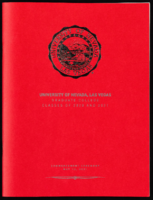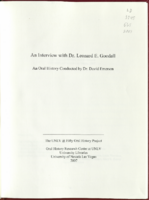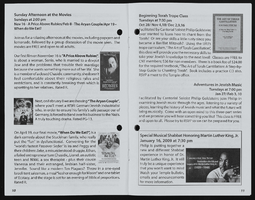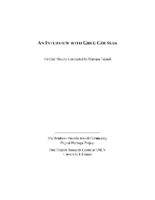Search the Special Collections and Archives Portal
Search Results
Jerry Morlan Professional Papers
Identifier
Abstract
This collection contains material that documents the career of technology educator Jerry Morlan (1938-2000), primarily in Las Vegas, Nevada. The bulk of the materials date between 1986-1996 and refer to Morlan's role in integrating technology into the classroom in the Clark County, Nevada School District. They include numerous letters of thanks and recommendation from schools throughout the county, as well as Morlan's professional writings and newspaper clippings related to his advocacy of vocational learning in the industrial arts. Also included in the collection is a group of photographs that visually document student projects Morlan directed during the 1980s, as well as a videocassette program from 1991 that offered an introduction to technology.
Archival Collection

University of Nevada, Las Vegas (UNLV) 41st commencement program
Date
Archival Collection
Description
Commencement program from University of Nevada, Las Vegas Commencement Programs and Graduation Lists (UA-00115).
Text
Larry Mason oral history interview
Identifier
Abstract
Oral history interview with Larry Mason conducted by Nathalie Martinez on September 14, 2018 for the Latinx Voices of Southern Nevada Oral History Project. In this interview, Mason discusses his upbringing by his Mexican immigrant parents in East Los Angeles, California and attending New Mexico State University. He describes receiving an athletics scholarship for basketball, playing in the European League, and earning a master's degree in education. Mason then talks about moving to Las Vegas, Nevada in 1984 to become Director of Admissions at the University of Nevada, Las Vegas, being elected to the Clark County School Board in 1993, and his work at the College of Southern Nevada as Vice President of Diversity and Cultural Affairs. Lastly, Mason explain his involvement with science, technology, engineering, and mathematics (STEM) education, minority students in STEM fields, his vision for public education, and the various community activities he has been involved in.
Archival Collection
Evelyn Stuckey Papers
Identifier
Abstract
The Evelyn Stuckey Papers date from 1940 to 1972 and document Stuckey's experience as a physical education teacher at Las Vegas High School (LVHS) in Las Vegas, Nevada and founder of the LVHS Rhythmettes dance group. The collection contains personal and educational materials from Stuckey’s college years, personal correspondence, and photographs. It also contains materials documenting the Rhythmettes' activities including travel plans, posters and fliers, news clippings, and group rosters.
Archival Collection

University of Nevada, Las Vegas (UNLV) 2020 and 2021 graduate college commencement program
Date
Archival Collection
Description
Commencement program from University of Nevada, Las Vegas Commencement Programs and Graduation Lists (UA-00115).
Text

Transcript of interview with Dr. Leonard Goodall by Dr. David Emerson, March 28, 2006
Date
Archival Collection
Description
Text
Patricia Iannuzzi oral history interviews
Identifier
Abstract
Oral history interviews with Patricia Iannuzzi conducted by Claytee D. White on March 6, 2018 and November 30, 2022 for the Boyer Early Las Vegas Oral History Project. In the first interview, Iannuzzi discusses her early interest in library sciences. She talks about her educational experience and becoming a reference librarian. Iannuzzi describes the development of resource repositories, education reform, and the evolution of the internet. Iannuzzi recalls the first online databases, electronic resources, and improving undergraduate education. Lastly, Iannuzzi discusses her employment at the University of Nevada, Las Vegas, and the importance of information literacy. In the second interview, Iannuzzi discusses accomplishments from her time as Dean of UNLV University Libraries, particularly her role in the creation of the Kirk Kerkorian School of Medicine at UNLV.
Archival Collection

Congregation Ner Tamid pamphlet: "A Sweet Year of Programming & Events, 5769 (2008-2009)"
Date
Archival Collection
Description
A Sweet Year of Programming & Events pamphlet for adult education, family programming, and special events from Congregation Ner Tamid on the Greenspun Campus for Jewish life, learning, and spiritual renewal. The pamphlet includes information on news, meetings, events, statements, and book reviews.
Mixed Content

Transcript of interview with Greg Goussak by Barbara Tabach, May 19, 2015
Date
Archival Collection
Description
Interview with Greg Goussak by Barbara Tabach on May 19, 2015. In this interview Goussak discusses his upbringing in Las Vegas, including his education in the Clark County School District and his experience with bussing to Sixth Grade Centers as the school district attempted to desegregate. As a teenager, he became involved with the B'nai B'rith Youth Organization through Temple Beth Sholom. Goussak talks about his mother's involvement with the Albert Einstein Hebrew Day School, which later moved and became the Dr. Miriam and Sheldon Adelson Educational Campus, and the kidnapping of Cary Sayegh. He then discusses finding his niche in accounting through taking an accounting course at UNLV as a high school student. Goussak talks about his education, career path as a controller in the gaming industry and public works projects, and becoming a professor.
Greg Goussak is a Las Vegas native, born January 1961, just after his parents moved to the city for his father's work as an accountant. His mother was a dedicated educator, who served throughout the city as a teacher and principal, including as the director of the Hebrew Day School in the 1970s. Greg's childhood was shaped by experiences with Las Vegas' sixth grade centers, challenges with scoliosis, and especially, involvement with B'nai B'rith Youth Organization (BBYO). In 1974, Greg helped start the city's new Aleph Zadik Aleph (AZA) chapter for BBYO, and his involvement with this youth organization became a formative part of his junior high and high school years. During this time, he became very involved with AZA at the regional, district and national levels, and made lifelong friends. As a high school student, Greg participated in UNLV's Early Studies Program, earning him college credit, and there he discovered his aptitude for accounting. He began tutoring fellow high school students in accounting, and thus, simultaneously discovered his passion for teaching. After earning his bachelor's degree in hospitality administration from UNLV in 1984, Greg got a job at Dunes Hotel and Casino, then under the leadership of Moe Shenker, working as an operations analyst. Over the next decade, Greg worked as a controller at several properties around town, including Nevada Palace, the Four Queens, Fitzgeralds, as well as a project on Boulder Highway. In 1992, seeking a reprieve from the gaming industry, Greg went back to UNLV to achieve his master's degree, in hotel administration. After graduating, he worked for Riviera Hotel and Casino, and established and oversaw their auditing department as well as box office. During this time, Greg met his wife Cynthia (Cindy) Riceberg, and the two were married in 1996. That same year, Greg took a position with Sigma Game, and soon after became Chief Financial Officer for Manpower Temporary Staffing. In 2002, deciding it was time to work for himself, he bought Haynes and Thomas Printers, which he owned and operated for the next eight years. Greg started teaching in 1989 as an adjunct professor in the William F. Harrah College of Hotel Administration at UNLV. In 2010, having finished his doctorate the year before, Greg assumed his first fulltime faculty position as an assistant professor at the University of Southern Nevada. The next year he was hired as an assistant professor at Ashford University, where he continues to teach today in the Forbes School of Business. Greg and Cindy have two daughters: Ariel, who is seventeen years old, and Alyssa, who is fourteen years old.
Text

Transcript of interview with Mitchell A. Cobeaga by Raymond E. Frey, March 14, 1976
Date
Archival Collection
Description
On March 14, 1976 Raymond E. Frey interviewed Vice President of Nevada State Bank, Mitchell A. Cobeaga (born December 11, 1917 in Lovelock, Nevada) at Mr. Frey’s home in Las Vegas, Nevada. This interview covers early life in Nevada and the history of the Nevada State Bank. During this interview Mr. Cobeaga also discusses education in Nevada in the twenties and thirties, and Southern Nevada’s influence over the rest of the state.
Text
